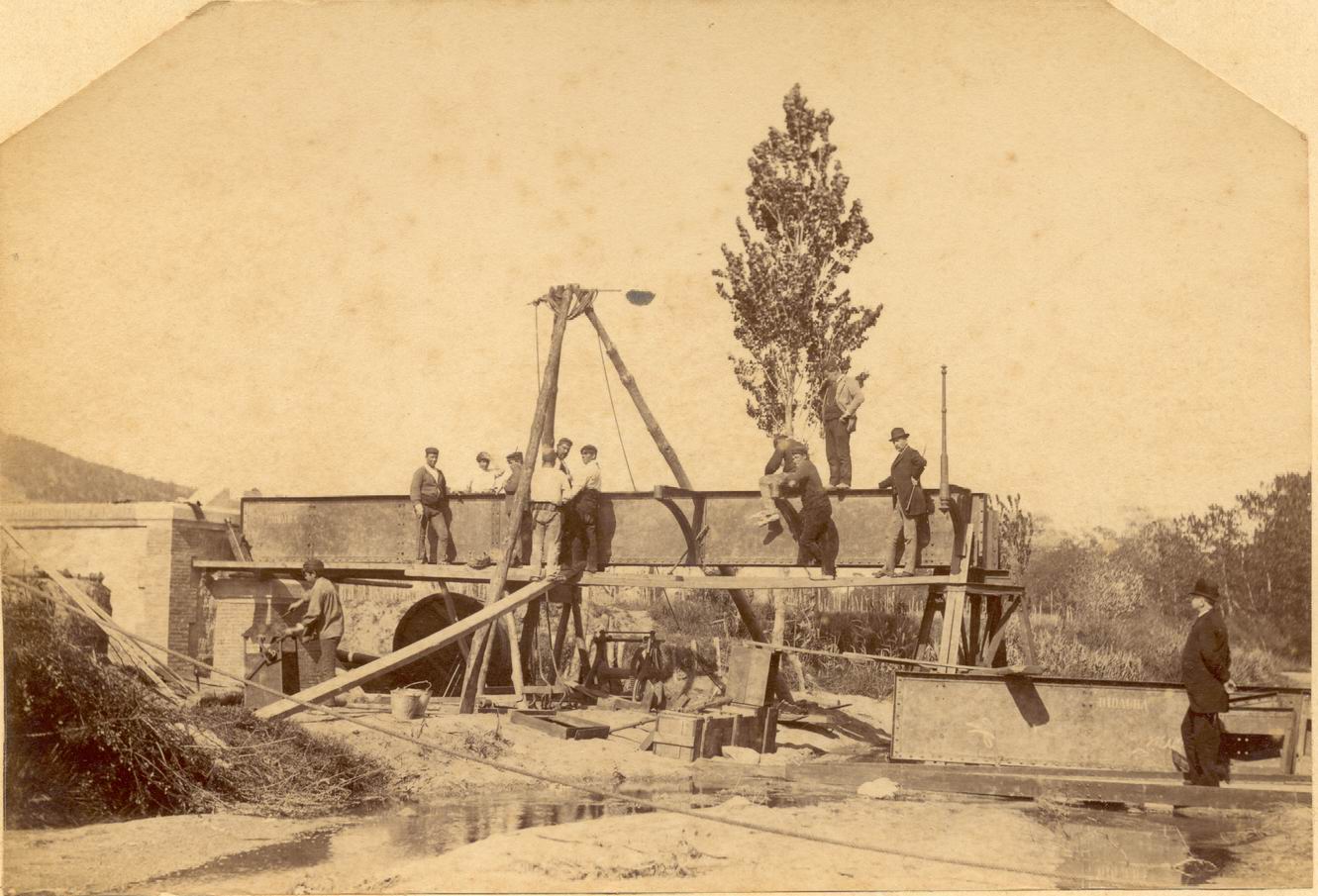Construction
The wording of the final draft after several drafts instructed the engineer Carlos Cardinal who had worked in the MZA and the Tram Baix Empordà (TBE).
This created a path for the line that avoided the tunnels, crossing the broad gauge in Gerona. In Sant Feliu were purchased some land in a good position to make the station and that made entry to rethink the entire train in Sant Feliu.
While before it begins already carrilet disparaged for its size, is a book of Henry Hériz entitled rail of 75 inches, which explains the functioning of several narrow gauge railways in Central Europe.
 Since launching the company, without any assistance and grant only that there was no charge, was launched in 1889 the work force by making two cuts on the line that would unite Llagostera, so that in 1890 already so advanced that they were called then, in mid-year rolling. In June 1890, reached the port of Sant Feliu Juan Cussningham steam which landed 310 tonnes of rails and track material that would be stored in Sant Feliu until early 1891 and was made much of the grading and placement claimed M. Jean Matewi debida a su experiencia en el Tranvía del Baix Empordà. Jean Matewi due to his experience in the Tram Baix Emporda.
Since launching the company, without any assistance and grant only that there was no charge, was launched in 1889 the work force by making two cuts on the line that would unite Llagostera, so that in 1890 already so advanced that they were called then, in mid-year rolling. In June 1890, reached the port of Sant Feliu Juan Cussningham steam which landed 310 tonnes of rails and track material that would be stored in Sant Feliu until early 1891 and was made much of the grading and placement claimed M. Jean Matewi debida a su experiencia en el Tranvía del Baix Empordà. Jean Matewi due to his experience in the Tram Baix Emporda.
Construction of the bridge over the river Ridaura
Photo belongs to the Municipal Archives of Sant Feliu
The construction lasted 3 years, the route chosen was not difficult, but the techniques of the time forced the workers to perform 11 hours or 12 hours.
In February 1891 came the first two locomotives to the months that followed the cars that made up the rolling stock, with them unable to perform a test train on 6 August that ran the length of track already laid in Sant Feliu Santa Cristina in ten minutes.
In early 1982 he produced the first delays due to heavy rains and the bridge over the river Onyar.
On 24 June 1892, escaped from Madrid permission to start the service.
As for the stations were divided for construction in the first category, Girona and Sant Feliu de Guixols and the rest who were second.
Overhead line work were made one, and the remaining metal on metal sections of 10 meters and was built in Barcelona by the engineer Alexandre Wolhguemuth en1891.
Formal Reality
In the construction of Sant Feliu train had to be taken into account many factors to consider in order to complete the work.
The construction company designated to perform the work, Lluís Garavetti of Barcelona began to have problems from the start with the expropriation of the land affected and the lack of insfraestructura and organizational capacity of the same company, it was determined by the cessation of work on the bridge over the river Ridaura twice for not having adequate means for pumping water into the foundation holes.
The organizational ability was questioned because of the constant fluctuations in recruitment, failing to provide a number of regular workers for various jobs on the line. That is worse when they start to produce the first accident, one death in the person of Maimí, Miquel of Llambilles.
This latest incident crosses the Lodovico Garavetti Gianna contract, but eventually the company terminates the contract in 1890.
The day of the opening of the line had been spent 3,141,860 pesetas. in the 175 engineering structures (bridges, culverts, and -7 steps lower and 6 upper and 131 level crossings, of which 3 were kept in chains, 6 oscillating barriers sliding barriers and 2).
The stations were divided into several more categories, so the first two of Sant Feliu de Guixols and Gerona were first class (the second always had temporary buildings), seasons were the second class of Cassa de la Selva and Llagostera, those of third category (Quart, Santa Cristina d'Aro and Castell) and halts Llambilles like the Font Picant Creueta and also the boxes of level crossings were kept the same standardized aspect of all stations on the line. In principle all have the same constructive and differences by the size and placements of the stations depending on the functionality of it.
 In all the years of operating the train from Sant Feliu only reached 3500 meters evil acquire new lane between 1924 and 1963. This significant wear dew behaved the way that came to be 13 kg / m in places. Especially in curves, where the road crews changed lanes only to replace worn-lane secondary roads from stations, while these lanes back to the place where they dried each other.
In all the years of operating the train from Sant Feliu only reached 3500 meters evil acquire new lane between 1924 and 1963. This significant wear dew behaved the way that came to be 13 kg / m in places. Especially in curves, where the road crews changed lanes only to replace worn-lane secondary roads from stations, while these lanes back to the place where they dried each other.
This became a serious concern especially after the arrival of locomotives 11 and 12, which "opened up" corners so that sometimes the locomotives that circulated after one of them derailed. Esto se hizo muy evidente en la época de los 50. This was most evident in the age of 50. Propició la venta pre cipitada de estas dos locomotoras a un ferrocarril industrial de Mieres. Led to the pre sale of two locomotives an industrial rail Mieres.
There were two major developments have been concentrated on two bridges on the line, one was due to a sharp slide flood that made the central sections of the river peunte Ridaura, prompting his replacement in 1913 by a second bridge had no pillar in the course of river.
In both black and white photos from the fund can be checked RENALD collection of material in Castell d'Arno and the state on the original bridge in 1913 Ridaura.
The formal reality in the end was that despite the desire to have a railroad has always been imbued with the people and in the region, but economic data began to be alarming from the 30s, which did not threaten the use rail due to the good work of some employees of the company that they struggled to take full advantage of all the material.
If you have information that may be interesting from a historical point of view and you can leave me, please send an email and we sill contact you. This site has no commercial interest.



